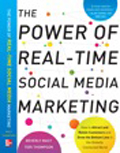In this excerpt from her new book The Power of Real-Time Social Media Marketing (co-authored with Teri Thompson), Beverly Macy offers a view of the global brain, world events, and the immense amount of metadata produced by social media platforms. Is it really just random, or are we following the laws of nature?
As a connected global society, people are sharing opinions, reviews, thoughts, and movements with one another all day, every day. That in itself is remarkable. We call it the real-time global brain. It represents a new form of openness that transcends media, politics, and boundaries and can serve as a powerful search engine, a breaking-news blaster, and an early-warning system. It is our collective intelligence. Every tweet, wall post, blog comment, and review is indexed by Google, Bing, and other search engines. A whole crop of technology companies are emerging to help marketers and companies make sense of this metadata in terms of influence and sentiment. Real-time conversations and posts may seem random, unreliable, or unmeasurable when in fact they can be quantified and analyzed.
As the body of metadata continues to grow, it becomes even more meaningful and intelligent, giving life to this dynamic global brain. There is a reason why, in early 2010, the Library of Congress of the United States announced it was going to archive all tweets back to 2006 and into the future. We are creating real-time data and historical data simultaneously. That is the Now Lens.
People and organizations are making practical use of real-time marketing data for promotion, communication, business development, awareness, lead generation, government services, and education. There is also a larger, more expansive view of how bits of information that are seemingly unconnected become an ecosystem with local, regional, and global implications for the individual, the corporation, institutions, and society. Is it possible that our flock of birds -- random bits of information streaming in real time -- might actually be responding to predictable laws of nature?
Consider chaos theory: "the theory of apparent randomness... whereby complex natural systems obey rules but are so sensitive that small initial changes can cause unexpected final results, thus giving an impression of randomness." Chaos theory was born from studies in the 1960s by Edward Lorenz, who discovered it accidentally while investigating weather predictions. This biological-atmospheric sensitivity is popularly referred to as the "butterfly effect" to describe how a butterfly fluttering its wings in the Amazon can cause a typhoon in Asia. "Large output from small input" is the phrase most often used.
The supposed influence exerted on a dynamic system by a small change in initial conditions certainly can be applied to what's happening in the collection of data and the real-time global brain. The three key elements of chaos theory are (1) nonlinearity, (2) system states, and (3) how things are ordered when they emerge from chaos. In real-time social media, a small bit (140 characters) that was dispersed in a nonlinear fashion (Twitter) appeared random but emerged as an organized $33 million-plus American Red Cross fund for Haitian earthquake victims. That is stunning.
Just as chaos theory states that little changes can have big impacts, the same holds true in real-time marketing. Simply stated, little things can mean a lot. Here is another example. Imagine a drop of rain falling on the peak of a mountain in the Continental Divide. If the raindrop falls just a fraction of an inch on the west side of the peak, it will end up flowing out to the Pacific Ocean. If it falls on the east of the peak, it will end up in the Gulf of Mexico. A very slight change in initial position can have a drastic change on the final outcome and a thus produce a potentially major impact.
We are living chaos theory in real-time with the presence of social communities and digital platforms that deliver communication in its multitude of forms almost as fast as thought. Real-time marketing is tasked with being an explorer, searching for innovation, market niches, diversity, alliances, acquisitions, and long-term forecasting in an unknown future. This requires disrupting traditional methods of planning, media buys, and customer relations. Standard marketing strategies and tactics are inadequate in this changing time. In complex, turbulent environments, speed in recognizing opportunities and responding is essential. At times, this will require flipping the model, such as starting with a new tactic and working backward to devise a strategy. The global business environment requires stakeholders to co-create the new real-time marketing blueprint at nano speed.
We find ourselves at a pivotal moment in marketing and business history in which real-time sentiment and conversation are the new currency and the ground is shifting beneath our feet. Yes, the basics of advertising, branding, and communicating still apply, but finding a way to integrate this newly surfaced component requires participants to take a different view of the world.
This new element, the Now Lens, calls for the ability to see the coming of age of conversational marketing in tandem with social technology platforms. It is the immediacy with which brands have to act and react to market conditions. It is consumers searching for trust in advertising by turning to their friends and peers for recommendations and reviews. It is listening and reacting to an explosion of user generated content.
More important than a pair of three-dimensional glasses, the real-time Now Lens with social media in its crosshairs has the attention of the most sophisticated companies on the plant, which want to harness collective intelligence for real-time competitive advantage.
 Excerpted from The Power of Real-Time Social Media Marketing by Beverly Macy and Teri Thompson (McGraw-Hill Professional). Reprinted by permission.
Excerpted from The Power of Real-Time Social Media Marketing by Beverly Macy and Teri Thompson (McGraw-Hill Professional). Reprinted by permission.
Beverly Macy, in addition to being an author, is the CEO of Gravity Summit, Inc. She also teaches Executive Global Marketing and Branding and Social Media Marketing for the UCLA Extension in Westwood, CA. Follow her on Twitter @PowerRTM; @GravitySummit
